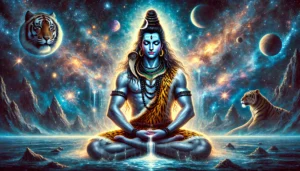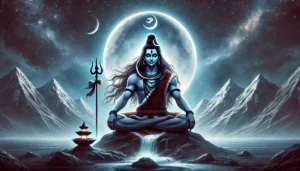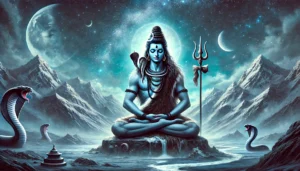
“Shiva, the Adiyogi: Exploring His Divine Role in Spirituality”
Shiva, the Adiyogi, is regarded as one of the most profound and enigmatic figures in Indian spirituality and mythology. He is recognized as the first yogi (Adiyogi) and the first teacher (Adi Guru), symbolizing the essence of yoga, meditation, and spiritual enlightenment. The presence of Lord Shiva transcends religious boundaries, with a timeless wisdom that guides humanity towards self-realization and inner transformation. In this article, a deep exploration will be undertaken into the divine persona of Shiva, his significance as the Adiyogi, and his enduring role in spiritual practices and philosophies.
“Shiva: The Cosmic Principle”
Shiva is more than just a deity; he represents a cosmic principle that governs the universe. In Hindu philosophy, he is often associated with the concept of destruction, but this destruction is not negative. It signifies the dissolution of ignorance, ego, and illusion to pave the way for creation and renewal. Shiva’s presence is integral to the cyclic nature of existence — creation, preservation, and destruction.
As the Adiyogi, Shiva embodies the ultimate potential of human consciousness. His meditative state on Mount Kailash symbolizes the pinnacle of spiritual achievement, where one transcends the physical and merges with the infinite.
“Shiva as the Adiyogi: The First Yogi”
The title “Adiyogi” signifies Shiva as the first practitioner and teacher of yoga. According to legend, over 15,000 years ago, Shiva attained an ecstatic state of meditation, radiating bliss and stillness. Intrigued by his aura, seven seekers approached him, seeking enlightenment. These seekers, known as the Saptarishis, became his first disciples.
For years, Shiva imparted his knowledge of yoga and the mechanisms of existence to the Saptarishis. The Saptarishis received this profound transmission, which became the foundation of yogic sciences. The knowledge spread across the globe and formed the basis of numerous spiritual traditions. Shiva is not only a symbol of transcendence but also the originator of practical tools for spiritual evolution.
Table of Contents
“The Yogic Dimensions of Shiva”
- The Meditative Master
Shiva is often depicted in a state of deep meditation, sitting cross-legged with half-closed eyes, his body covered in ash. This image is often used to symbolize his detachment from materialism and his immersion in the infinite. His meditative posture is a reminder for seekers to turn inward, quiet the mind, and connect with the universal consciousness.
- The Tandava: Dance of Destruction and Renewal
Shiva performs the cosmic dance, known as the Tandava, which symbolizes the dynamic interplay between creation and destruction. In this dance, each movement serves as a metaphor for the various stages of life – from birth and growth to dissolution. The Tandava teaches that destruction is not the end but a necessary part of the cycle for renewal and transformation. Through this aspect, Shiva motivates individuals to embrace change and release their attachments.
- Ardhanarishvara: The Unity of Masculine and Feminine
Shiva as Ardhanarishvara, the half-male and half-female form, represents the perfect balance between masculine and feminine energies. This union emphasizes the importance of harmony and wholeness in spiritual practices. It signifies that true enlightenment comes when one transcends dualities and embraces the oneness of existence.

shiva the Adiyogi
“Shiva’s Role in Spirituality”
- The Destroyer of Ego
In spiritual terms, the ego acts as a significant barrier to self-realization. Seekers can dissolve their ego and illusions with the help of Shiva, who is known as the destroyer. By surrendering to Shiva, individuals can learn to transcend their personal limitations and merge with the universal consciousness.
- The Lord of Time (Mahakaal)
Shiva is also referred to as Mahakaal, the Lord of Time. He reminds us of the impermanence of life and the need to focus on the eternal. In spiritual practice, this awareness encourages individuals to live in the present moment, free from the burdens of the past and anxieties about the future.
- The Source of Inner Stillness
In the chaotic world, Shiva offers a pathway to inner stillness with his meditative demeanor. His teachings inspire seekers to practice mindfulness, silence their minds, and find peace within. Seekers who follow Shiva’s teachings will lay the foundation for their spiritual growth and enlightenment through cultivating inner stillness.
- A Guide to Transcendence
Shiva often goes by the name Bholenath, the innocent one, because of his approachable and compassionate nature. He welcomes all, regardless of their background, and guides them on the path to transcendence. This inclusivity reflects the universal appeal of Shiva’s teachings, which resonate with people across cultures and religions as he invites them to join him in their journey towards enlightenment.
“Symbolism in Shiva’s Iconography”
The various elements of Shiva’s iconography carry deep spiritual significance:-
Third Eye : Shiva’s third eye represents the awakened consciousness that sees beyond the physical and perceives the ultimate truth.
Crescent Moon : The crescent moon on Shiva’s head symbolizes time and its cyclical nature. It also represents the mastery over time and the mind.
Trishul (Trident) : The trident signifies the three fundamental aspects of existence — creation, preservation, and destruction. It also represents the three gunas (qualities): sattva, rajas, and tamas.
Damru (Drum) : The damru symbolizes the primordial sound, “Om,” which is the source of creation.
Ashes : Shiva’s ash-covered body signifies detachment and the impermanence of the physical form.
Ganga Flowing from His Hair : The Ganga symbolizes purity and carries the flow of spiritual knowledge. It also serves as a metaphor for Shiva purifying sins and providing liberation. The river represents Shiva’s role as a purifier and liberator.

Shiva the Adiyogi
“Shiva and Yogic Practices”
Shiva’s teachings form the bedrock of yogic practices that aim to harmonize the body, mind, and soul. Some of the key aspects of Shiva-inspired yoga include:-
Meditation : Inspired by Shiva’s meditative state, meditation helps seekers quiet their minds and access higher states of consciousness.
Pranayama (Breath Control) : The breath is seen as a bridge between the physical and spiritual realms. Pranayama practices cleanse and balance the body’s energy channels.
Kundalini Awakening : Shiva often associates himself with the awakening of Kundalini energy, the dormant spiritual energy at the base of the spine. Practitioners of yoga can harness this energy through various practices, allowing it to rise and ultimately achieve spiritual enlightenment.
Mantras and Chanting : The chanting of Shiva-related mantras, such as “Om Namah Shivaya,” invokes his energy and aids in spiritual transformation.
“Shiva’s Universal Appeal”
Shiva’s teachings transcend religious and cultural boundaries as they are deeply rooted in Hinduism but appeal to seekers from diverse spiritual traditions. Anyone on a quest for self-discovery and inner peace resonates with his archetype as the Adiyogi. His essence appeals to seekers beyond Hinduism.
Shiva’s inclusivity also shines through in the festivals dedicated to him, such as Maha Shivaratri, where devotees from across the world actively participate in night-long meditations, fasting, and prayers. They seek his blessings for liberation and celebrate his union with Shakti, as well as his role as a spiritual guide.
“Modern Relevance of Shiva’s Teachings”
In today’s fast-paced world, Shiva’s teachings hold immense relevance as he emphasizes mindfulness, detachment, and balance which are crucial for navigating the stresses of modern life. Shiva, in his role as the Adiyogi, provides practical tools for personal growth and spiritual awakening, making his teachings timeless and universally applicable.
Facts about Lord Shiva being “Adiyogi”
Lord Shiva is revered as the “Adiyogi,” meaning the first yogi, and the originator of yoga. According to ancient Indian texts, he is said to have attained the highest state of enlightenment and shared his profound knowledge with humanity, laying the foundation for yoga as a science of inner transformation, that’s why Lord Shiva is called as Shiva the Adiyogi.
In yogic tradition, it is believed that Shiva first imparted this knowledge to the seven sages, known as the Saptarishis, on the banks of Lake Kantisarovar near Mount Kailash. These sages became his first disciples, spreading yoga to different parts of the world. Shiva’s teachings encompassed physical postures (asanas), breathing techniques (pranayama), and meditative practices, designed to lead individuals to self-realization.
Symbolically, Shiva as Adiyogi represents the union of cosmic energies and the ultimate potential of human consciousness. His meditative posture signifies a state of perfect harmony and balance. The snake around his neck and the crescent moon on his head are symbolic of mastery over time and energy.
Modern celebrations, such as the unveiling of the 112-foot Adiyogi statue in Coimbatore, India, further honor Lord Shiva’s role as the father of yoga and the eternal guide to spiritual seekers worldwide.
Conclusion
Shiva the Adiyogi, is not just a deity to be worshipped but a living embodiment of spiritual principles that guide humanity toward higher consciousness. His meditative state, yogic teachings, and symbolic wisdom offer a profound pathway to self-realization and liberation. In understanding Shiva’s role in spirituality, one discovers the essence of existence — the infinite, the eternal, and the divine.
Through Shiva the Adiyogi, it is reminded that the journey inward is considered the most significant of all, and the ultimate truth is believed to lie within. Whether through meditation, yoga, or devotion, Shiva continues to inspire millions to seek the divine within themselves and connect with the boundless universe.
FAQs: Shiva, the Adiyogi – Exploring His Divine Role in Spirituality
- Who is Shiva, the Adiyogi?
Shiva, referred to as the Adiyogi, is considered the first yogi and the originator of yoga. In spiritual traditions, he symbolizes the ultimate teacher who shared the knowledge of yoga to help humanity transcend limitations and achieve spiritual liberation.
- What does “Adiyogi” mean?
The term “Adiyogi” translates to “The First Yogi.” It signifies Shiva’s role as the pioneer of yoga and meditation, offering the path to self-realization and universal consciousness.
- Why is Shiva important in spirituality?
Shiva is revered as a deity of transformation and destruction of ignorance. His teachings guide individuals toward inner balance, enlightenment, and harmony with the universe. His meditative state is a symbol of eternal peace and detachment.
- What is the connection between Shiva and yoga?
Shiva is considered the creator of yoga, sharing this profound practice with his disciples, the Saptarishis (seven sages). Yoga, as taught by Shiva, integrates physical, mental, and spiritual practices to help seekers connect with the divine.
- What is the significance of Shiva’s meditative posture?
Shiva’s meditative posture represents stillness, awareness, and detachment from worldly distractions. It encourages practitioners to cultivate mindfulness, self-discipline, and a deeper understanding of their inner selves.
- What is the role of the Saptarishis in spreading Shiva’s teachings?
The Saptarishis, or seven sages, were the first disciples of Shiva. They carried the knowledge of yoga and spirituality across the world, establishing the foundation for various spiritual traditions.
- How can one connect with Shiva spiritually?
One can connect with Shiva through meditation, chanting mantras like “Om Namah Shivaya,” practicing yoga, and embracing qualities like detachment, inner peace, and self-discipline. Understanding his teachings helps seekers align with universal energies.
- What is the significance of Shiva in modern spirituality?
Shiva’s teachings remain relevant in modern times as they promote mindfulness, self-awareness, and balance in life. His emphasis on meditation and self-realization resonates deeply with contemporary spiritual seekers.
- How does Shiva’s role as the Adiyogi inspire personal transformation?
Shiva inspires individuals to transcend limitations, overcome ego, and embrace their true potential. His example as the Adiyogi encourages seekers to explore inner dimensions, achieve spiritual growth, and connect with the infinite.
- What are some symbols associated with Shiva, and what do they represent?
Third Eye: Represents wisdom and insight beyond ordinary perception.
Trishul (Trident): Symbolizes balance among creation, preservation, and destruction.
Nandi (Bull): Signifies strength, devotion, and righteousness.
Crescent Moon: Represents control over time and cycles of change.
- Can anyone follow Shiva’s teachings, regardless of religion?
Yes, Shiva’s teachings on yoga, meditation, and spirituality transcend religious boundaries. They are universal practices designed to help individuals achieve self-awareness and inner peace.
- What is the role of Shiva in the context of Indian mythology and culture?
Shiva is a central figure in Indian mythology, representing destruction for renewal and transformation. He is a key deity in Hinduism and a source of inspiration for art, philosophy, and spiritual practices in Indian culture.
Shiva the Adiyogi Shiva the Adiyogi Shiva the Adiyogi Shiva the Adiyogi Shiva the Adiyogi Shiva the Adiyogi Shiva the Adiyogi Shiva the Adiyogi Shiva the Adiyogi Shiva the Adiyogi Shiva the Adiyogi Shiva the Adiyogi Shiva the Adiyogi Shiva the Adiyogi Shiva the Adiyogi Shiva the Adiyogi Shiva the Adiyogi Shiva the Adiyogi
